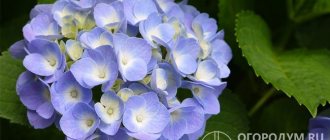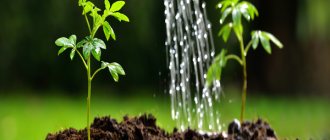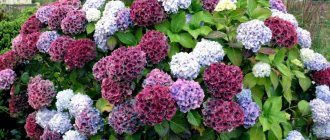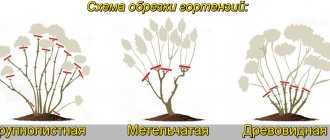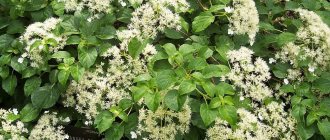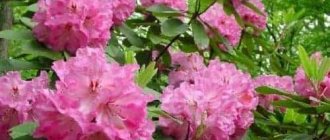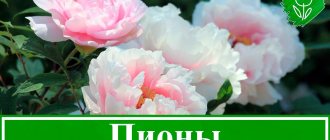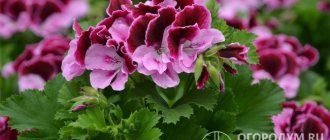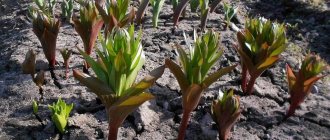How to feed hydrangea in spring
Hydrangea needs macro- and microelements, especially iron. Acidic soils are best suited for growing. Fertilizing in the spring and in the subsequent period is carried out taking into account the needs for nutrients. The shrub needs:
- nitrogen, which is responsible for the growth of green mass, succulent leaves and powerful shoots. It is important not to overdo it, otherwise the growth of greenery will be to the detriment of the flowers;
- phosphorus, provides a large number of flowers and their sizes, as well as the duration of flowering and the ability to overwinter;
- potassium ensures better flowering in the spring, and in the fall it is responsible for the frost resistance of the shrub and provides energy for the formation of buds in the future;
- microelements responsible for various processes. Magnesium is important during the period of bud setting and affects the brightness of flower color. Iron deficiency increases the risk of chlorosis, etc.
If fertilizing is carried out correctly in spring and summer, hydrangea pleases with bright green foliage, timely formation of buds and long, lush flowering. The bush gets sick less and can withstand temperature changes and other adverse weather conditions.
An important addition: if you properly feed the hydrangea during planting in the hole, you can not add anything to the soil for the next couple of years.
Mineral and organic fertilizers
There are many feeding options. Some are more expensive, others require almost no cost. Flower growers insist that all types of garden hydrangeas need care - paniculate, tree-like, large-leaved, and less common.
An approximate list of means used to fertilize hydrangeas in the spring and in the future includes:
- nitrogen fertilizer. Shown only in spring, when the snow melts. If there is excess nitrogen in the soil, the foliage will be lush and flowering will be sparse and rapid. Mineral fertilizers you can use are urea (15 g per 10 liters of water), ammonium nitrate (up to 30 g per bucket of water). Chicken manure is suitable for organic matter - the concentrate is prepared by diluting the manure with water in a ratio of 1:20, for application - 1:3. You can use mullein, nettle infusion, and also mulch the shrubs with humus, compost, and peat;
- complex mineral fertilizers for hydrangea. Nitroammophoska is suitable, in which the 3 main elements contain 16% each. Take 20–30 g of the composition per bucket of water, pour 5 liters under each bush. For fertilizer after flowering or in the fall, use diammofoska, in which the nitrogen content is reduced, and potassium and phosphorus - 26% each. The composition is diluted at the rate of 20 g per 10 liters. Considering that the listed compositions do not contain microelements, they are added separately in the form of humates;
- phosphorus-potassium compounds. Used during budding to ensure lush flowering. The most popular fertilizers are superphosphate (up to 20 g per 10 l), double superphosphate (the dose is halved), potassium sulfate (up to 20 g per 10 l). Instead of potassium sulfate, potassium salt or potassium magnesium is often used, which includes magnesium, which is useful for hydrangea;
- humates. Improves the plant's absorption of complex fertilizers.
Wood ash is not used for hydrangeas because it reduces the acidity of the soil. An exception is made when you plan to get pink hydrangeas.
Ready-made formulations
Feeding the plant will cause less trouble if you use more expensive specialized formulations containing a complex of necessary micro- and macroelements. The most popular known:
- “Fertika Kristalon” with microelements;
- "Agricola" with humates and microelements;
- Bona Forte with vitamins, microelements and succinic acid;
- "Buy fertilizers" in granules and powder with microelements.
It is important to consider that some formulations change the color of plants to blue.
Fertilizing hydrangeas in the spring with long-acting formulations is successful. Usually these are granules that are added dry around the bushes into pre-prepared holes. It is enough to add the additive once per season, and nothing else is required.
Folk remedies
One of the unusual fertilizers for hydrangeas is kefir. For a bucket of water take 2 liters of kefir, sour milk, fermented baked milk. Another option is to use a yeast solution (mix 10 liters of water, 10 g of yeast and 5 tsp of sugar) or live beer.
You can use foods that are sour but do not contain salt. To strengthen the shoots, use a slightly pinkish solution of potassium permanganate. It will prolong flowering and make flower heads larger. The effectiveness of improvised means is inferior to mineral fertilizer, but they are cheaper.
Nuances
This shrub has a number of features, so when cultivating it is important to know not only what fertilizers to apply to the hydrangea, but also when exactly it is needed, and also in what order.
Feeding gives the following result:
- allow you to maintain the soil parameters that this plant needs;
- allow the crown to quickly grow;
- improve the branching of the root system;
- influence the number of buds;
- increase plant immunity to diseases;
- make it possible to regulate the color intensity of the inflorescences;
- make the bush more resistant to adverse weather conditions;
- enhance photosynthesis activity;
- reduce the risk of freezing in cold weather.
These effects simplify cultivation and increase the decorative properties of plants.
Rules for applying fertilizing
Decorative flowers require no less attention than other crops on the site. Hydrangeas do not produce a harvest, but they are ways to transform the area during their flowering period. When feeding hydrangeas, experienced gardeners are guided by the following rules:
- The first time after winter, fertilizer is applied when the snow has completely melted and the temperature has stably established above zero. When the soil warms up to +4...+6 degrees, the roots of the flower are ready to absorb from the environment the elements they need for development.
- Dry fertilizer for hydrangea is scattered on the ground, and then loosened to a depth of 5 cm, followed by watering the soil.
- The use of liquid solutions requires preliminary moistening of the soil. The day before applying the preparations, the bush is well watered so that the root system does not get burned, but intensively absorbs the useful components of the fertilizing.
- For leaf spraying of bushes, the dosage is reduced by half compared to the norms for watering. Spraying is scheduled for the evening or performed on a cloudy day so that the leaves do not get sunburn.
- An overdose of drugs can also cause burns to the green part and roots.
Hydrangea prefers acidic soil, so to feed the flower you cannot use fertilizers that reduce its acidity: manure, wood ash, etc.
Special preparations
In addition to universal complexes suitable for all crops, there are specially developed complex fertilizers for hydrangea. They take into account the special needs of this particular plant. The ingredients contain not only macroelements, but also macroelements, as well as vitamins, which are necessary for the normal development of the bush. At the same time, mild acidification of the soil occurs.
Experts recommend the following special medications:
- FLOROVIT. Granular additive. It dissolves very slowly, even with heavy rains it does not quickly pass into the lower layers of the soil. Provides rapid growth, intense coloring of inflorescences and increases the frost resistance of the bush. After application, fewer shoots have to be removed the next year due to freezing.
- PLANTON H. 100% soluble in water and causes slight acidification of the soil, during which nutrients are better absorbed. Since the complex is concentrated, a 1 kg bag is enough for 200 liters of water.
- Agrecol. Multicomponent granules that are quickly absorbed and provide a visible effect.
- Valagro. Italian drug. Increases the number of buds and improves the plant's immunity. Completely dissolves in water, provides bright colors of leaves and flowers, and significantly increases the duration of flowering.
- Substral. Fertilizer made in Germany, gentle on the plant. It is very concentrated, so one package is enough for the whole season to feed 3-4 plants.
- Ekote. An effective and high-quality product from the Netherlands. It features a perfectly balanced mineral formula that can be used at different stages of the growing season.
- Biopon. A product that increases the decorative properties of the crop and improves resistance to fungal and bacterial diseases.
Even experts cannot name the best fertilizer for hydrangea, since each of them has its own advantages, but in the end, each of them will make the crop more attractive and viable.
Fertilizer application timing
The first feeding of hydrangea in the spring is designed to stimulate active plant growth, and therefore has a high nitrogen content. After 2 weeks, the flower is watered with compounds that strengthen the wood. If necessary, additionally acidify the soil. The next treatment of hydrangeas is carried out in late spring to accelerate the growth of bush shoots. Approximate feeding scheme for hydrangeas:
- from April 10 to April 18 - nitrogen-containing preparations;
- May - spraying with compounds containing manganese, which strengthens the shoots and makes them flexible;
- early June - comprehensive plant nutrition, including a set of components necessary for growth and development.
Inorganics
Three main macroelements are decisive for the development and flowering of this crop: nitrogen, phosphorus and potassium.
Nitrogen compounds
Nitrogen is the main element that is consumed during the construction of new cells, so during active growth it turns into a substance of primary importance. In the first years after planting, nitrogen consumption is maximum.
The most common nitrogen compounds:
- Ammonium sulfate. Since this compound contains sulfur, it is considered an ideal fertilizer when planting hydrangea: sulfur slightly acidifies the substrate.
- Urea (another name is urea).
- Ammonium nitrate.
These substances are water soluble. When dissolved, they cause the solution to cool, so you can use warm water no higher than 30° so that the solution is not too cold and can be used immediately.
Potassium-phosphorus compositions
Potassium and phosphorus are necessary for bud formation, flowering and to prepare the plant for winter. It is recommended to use the following formulations:
- Potassium sulfate. Gently acidifies the soil.
- Potassium nitrate. Allows you to immediately saturate the substrate with two important macroelements - potassium and nitrogen.
- Calimagnesia. Serves as a source of magnesium and potassium.
- Superphosphate.
- Monophosphate.
- Potassium monophosphate.
Compounds containing phosphorus do not dissolve so well in water, but for the same reason they last longer. To make the preparation of the solution faster, you can take warm water and stir until all the granules are dissolved. If this is not done, the concentration of the solution will be uneven, and the last plants may get burned from a large amount of minerals.
How to feed hydrangea in spring for lush flowering
Hydrangeas are fertilized in the spring to help the plant fully emerge from the winter dormancy phase. Nitrogen is responsible for growing greenery and stimulating growth. The choice of nitrogen-containing fertilizers depends on the budget and size of the site, as well as the needs of the soil. The first time the bushes are fertilized is about 2 weeks after the snow melts. If the soil is not warmed up enough until then, the procedure is postponed. At this time, the plant will be helped by urea with potassium sulfate. 40 g of each substance are dissolved in a bucket of water. For 1 planting you will need 5 liters of ready-made solution.
Organic substances can be used instead of chemicals. Liquid manure diluted with water in a ratio of 1:10 works well. Choosing such a fertilizer for hydrangeas is advisable when growing flowers on neutral and alkaline soils. If the soil is podzolic, ammonium nitrate will help acidify it to the desired level.
The plant is fed the second time when the leaves have blossomed, but there are no flowers yet. The need for fertilizing with one or another type of fertilizer is determined by the appearance of the shrub. If the hydrangea looks healthy, choose potassium-containing preparations. If you notice signs of chlorosis, it is worth repeating nitrogen fertilizing.
The choice of drug and method of application also depends on weather conditions. When the ground is abundantly wet with rain, it is enough to scatter the dry preparation under the bushes and cover it with soil. In drier conditions, a liquid preparation will be needed. If you follow the terms and rules of fertilizing, hydrangea will delight you with its lush color for a long time.
How to feed hydrangea to change color
To acidify the soil and change the color of plants, once a month or more often use solutions of a weakly acidic electrolyte (10 ml per bucket of water), apple cider vinegar (100 ml of vinegar per bucket of water), or dissolve 20–40 g of dry citric acid in 10 liters of water. There will be more benefits if you add iron sulfate or iron chelate (20 g per 10 liters of water).
The color of plants is regulated by correcting the acidity of the soil - the more acidic it is, the more blue and purple tints will be obtained. If the pH is about 6–6.2, then the flowers will be crimson or pink.
Pests and diseases
Growing hydrangea
Hydrangea is hardy and resistant to various pests and diseases. But sometimes you have to fight with some of them:
- Chlorosis is manifested by leaves that have become lighter and have lost their bright color. This disease develops due to the abundance of lime and humus in the soil. It can be cured by using a solution of iron sulfate or potassium nitrate, spraying the plant at intervals of three days.
- Downy mildew appears when the air humidity is high and manifests itself in the appearance of yellow spots on the foliage, which then turn dark brown. In this case, the plant must be treated with a solution containing soap and copper sulfate.
- The plant can be affected by aphids, spider mites and sharp nose . To eliminate them, it is recommended to use insecticides; traditional methods include using a solution with laundry soap.
- Fungus is rare; when it appears, you need to treat the hydrangea using copper oxychloride.
- Snails - if their clutches of eggs are detected, you need to place special chemicals in containers under the plant bush.
Useful tips
Only if fertilizing is carried out correctly and accurately will the hydrangea be lush and bloom brightly. Basic recommendations:
- Before adding additives to the soil, you should step back 20 cm from the trunk of the bush, make a shallow groove, water or pour the composition, and then cover with compost, acidic peat or humus;
- the ground is well moistened beforehand, with the exception of the period immediately after rain;
- fertilizing is carried out in the evenings or early in the morning, while sun activity is low;
- In the spring, root feeding is more often used; in the summer, foliar feeding is used.
Foliar treatment cannot replace root fertilizer. The timing and dosage are selected taking into account the manufacturer’s recommendations, weather conditions and soil composition.
Caring for hydrangea in autumn and preparing for winter
After flowering, caring for hydrangea in the fall consists of removing faded inflorescences and preparing for winter.
- Tree hydrangea does not need to be covered for the winter; mulching is enough - it has high winter hardiness.
- In the conditions of the Middle Zone, the Moscow region, the North-West, the Urals and Siberia, be sure to cover the hydrangea for the winter, and it is better to dig up large-leaved hydrangea, replant it in pots and bring it into the house. Since this species can be grown in areas where the temperature in winter is not lower than -23.5 °C. The exception is some modern winter-hardy varieties mentioned in the “pruning” section.
- In more southern and warmer areas, you can get by with hilling and mulching.
Preparing for winter and covering hydrangeas
Inflorescences appear on last year's shoots (large-leaved hydrangea), and the goal is to completely preserve them from frost and damping off.
Since the leaves and flowers of large-leaved hydrangea are killed by light frosts at night, preparations for winter begin in mid-to-late October (after the first frost).
- Garden paniculata and large-leaved hydrangea must be covered for the winter.
- To do this, the bush is covered with earth, and the tree trunk circle is mulched with rotted manure, pine needles or peat.
- Then the stems are bent to the soil and covered with sawdust, spruce branches or dry leaves. And a box (box) is placed on top of the bush.
- After the end of spring frosts (April), the winter shelter is dismantled and pruned.
- It is better to carefully tie a large bush and make a frame shelter over it (“hut”) 8-12 cm higher than it and pour dry leaves inside it.
Preparing hydrangea for winter
Sheltering hydrangeas for the winter
Top layer of winter cover for hydrangeas
During short-term frosts, it is convenient to cover with lutrasil, white burlap or a double layer of film.
Shelter for large-leaved hydrangea for the winter from a gardener from the Moscow region
- In the fall, before night frosts arrive, cut off all the leaves from the bush. If you leave them, the flower will begin to rot. Leave only the flower buds at the tips of the branches, with a maximum of two leaves protecting them.
- Tie all the branches on the bush, 3-4 pieces of approximately the same size, into separate bundles with elastic material (elastic band, tights, strips of fabric).
- Bend the bundles as low as possible to the soil and secure with metal brackets (electrodes, thick wire). You need to bend the hydrangea to the ground carefully so as not to damage the shoots. In some varieties they become very lignified and it is better to bend them down gradually, starting with a slight slope.
- Before the start of cold weather (mid-November), cover the hydrangea with any non-woven material (burlap, agrofibre).
- Before the onset of severe frosts, remove the cover and cover the flower with dry peat, compost or leaf soil. The base of the bush is less afraid of frost than the fragile tips of the shoots, so it is sprinkled with very little.
- Place arcs over the plant and pull the covering material again, and place a piece of film on top so that the ends remain open and there is no increased humidity inside the winter shelter.
Shelter for the winter of young hydrangea
Young seedlings are not pruned, but are simply brought into the house for the winter in pots or covered with earth and additionally covered for the winter with an 11-16 cm layer of peat, dry leaves, pine needles or sawdust.
When can you open hydrangeas after winter?
In spring, you need to remove the winter cover from the hydrangea at the appropriate time to prevent the shoots from damping off.
- In mid-March, remove the film and covering material, rake out the peat or soil and cover again with burlap.
- In early April, when the night frosts end and stable warmth sets in, remove the cover from the large-leaved hydrangea completely.
Approximate dates for the Moscow region are indicated.
Winter hardiness of hydrangea
Now large-leaved hydrangea is increasingly grown in central Russia and in the Moscow region, the Urals and Siberia. However, not all winter-hardy varieties are able to bloom in any area due to different microclimates.
The plant can withstand temperatures down to -23 °C, and the most winter-hardy are tree, paniculate and ground cover hydrangeas.
The plant's winter hardiness increases if it receives a sufficient amount of water in the fall, as well as potassium-phosphorus fertilizer.
